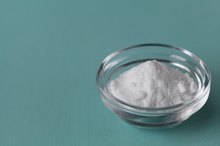Calcium Carbonate and Kidney Stones
Approximately 7 percent of American women and 13 percent of American men will have a kidney stone at some time in their life, according to John Asplin, M.D., Medical Director of the Litholink Corporation in “Harrison’s Principles of Internal Medicine.” There is more than one type of kidney stone and calcium carbonate may or may not increase the risk of developing one 1.
The Types of Kidney Stones
There are four main types of kidney stones. An estimated 75 to 85 percent of all stones are made of calcium oxalate or calcium phosphate, and approximately half of the people who develop a calcium stone will experience another one within 10 years, writes Dr. Asplin. The next common type is called a struvite stone, which is made of magnesium, ammonium and phosphate. There are also uric acid stones and cystine stones.
- There are four main types of kidney stones.
- An estimated 75 to 85 percent of all stones are made of calcium oxalate or calcium phosphate, and approximately half of the people who develop a calcium stone will experience another one within 10 years, writes Dr. Asplin.
How Kidney Stones Form
Drugs That Dissolve Kidney Stones
Learn More
Calcium oxalate and calcium phosphate stones primarily form when people have a high amount of calcium in their urine, explains Glenn Preminger, M.D., Director of the Comprehensive Kidney Stone Center in “The Merck Manual for Healthcare Professionals.” They can also develop from a kidney disease called renal tubular acidosis, from having a low urine level of a substance called citrate, or a high amount of oxalate or even vitamin C. Struvite stones develop from a urinary tract infection caused by certain bacteria, while a high level of uric acid can cause:
- uric acid stones,
- a kidney disorder can lead to cystine stones 2
What is Calcium Carbonate?
Calcium carbonate is a supplement that provides calcium to people who do not get enough calcium in their diet. It is also used as an antacid. Susan Ott, M.D., Professor of Medicine at the University of Washington explains that some manufacturers use calcium carbonate as a supplement while others use calcium citrate, but the intestines equally absorb both kinds 3. It is cheaper, however, for manufacturers to make calcium carbonate in a form that takes longer to dissolve. Dr. Ott writes about one patient who found an undissolved calcium tablet in her apron pocket after the apron had been through the washer and dryer.
- Calcium carbonate is a supplement that provides calcium to people who do not get enough calcium in their diet.
- Susan Ott, M.D., Professor of Medicine at the University of Washington explains that some manufacturers use calcium carbonate as a supplement while others use calcium citrate, but the intestines equally absorb both kinds 3.
Calcium Carbonate and Kidney Stones
What Is the Largest Kidney Stone a Person Can Pass?
Learn More
The recommended dose of calcium for people 19 to 50 years old is 1,000 milligrams every day and 1,200 milligrams each day for those over 50 years old, according to the National Institutes of Health. In addition, the intestines absorb calcium better if it is taken several times during the day. According to Dr. Ott of the University of Washington, if people have more than 2,000 milligrams of calcium carbonate every day, they are at an increased risk of developing kidney stones 3.
Related Articles
References
- Harrison’s Principles of Internal Medicine: Anthony Fauci, M.D., Dennis Kasper, M.D., Dan Longo, M.D. et al.; 2008
- The Merck Manual for Healthcare Professionals: Urinary Calculi
- University of Washington: Calcium to Treat and Prevent Osteoporosis
- Trailokya A, Srivastava A, Bhole M, Zalte N. Calcium and calcium salts. J Assn Physician India. 2017 Feb;65:100-3.
- National Institutes of Health. Calcium: Fact sheet for health professionals. Updated October 16, 2019.
- Shankar K, M S, Raizada P, Jain R. A randomized open-label clinical study comparing the efficacy, safety, and bioavailability of calcium lysinate with calcium carbonate and calcium citrate malate in osteopenia patients. J Orthop Case Rep. 2018;8(4):15-9. doi:10.13107/jocr.2250-0685.1138
- Ahmed A, Azim A, Gurjar M, Baronia AK. Hypocalcemia in acute pancreatitis revisited. Indian J Crit Care Med. 2016;20(3):173-7. doi:10.4103/0972-5229.178182
- Uwitonze AM, Razzaque MS. Role of magnesium in vitamin D activation and function. J Am Osteopath Assn. 2018 Mar;118:181-9. doi:10.7556/jaoa.2018.037
- Parva NR, Tadepalli S, Singh P, et al. Prevalence of vitamin D deficiency and associated risk factors in the US population (2011-2012). Cureus. 2018;10(6):e2741. doi:10.7759/cureus.2741
- Lamy O, Burckhardt P. Calcium revisited: part II calcium supplements and their effects. Bonekey Rep. 2014;3:579. doi:10.1038/bonekey.2014.74
Resources
Writer Bio
Based in North Carolina, Ruth Coleman has written articles and manuals for more than 25 years. Her writing has appeared in community newspapers and places of employment. Coleman holds a Bachelor of Science in biology from Salem College, a Doctor of Medicine from Ross University and is the recipient of numerous academic awards.









